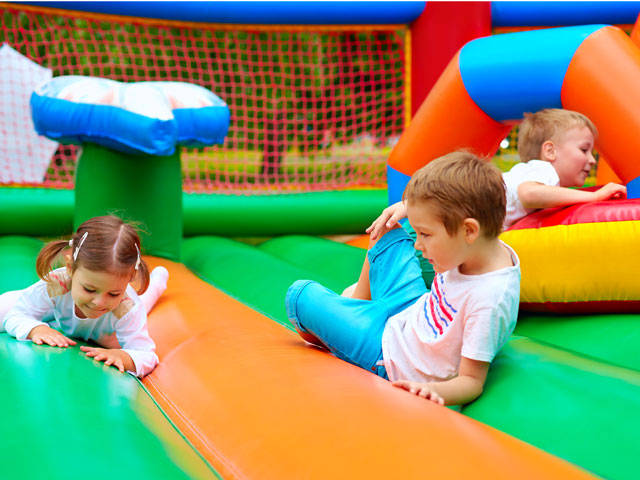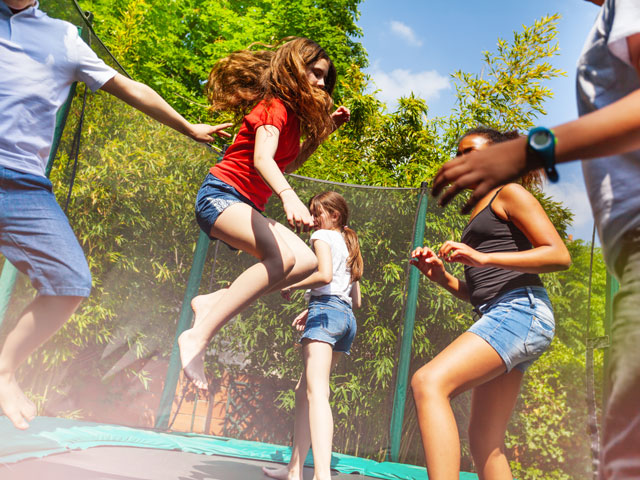Does a Bounce House Have a Weight Limit?
Gosh, we love bounce houses. What better way to enjoy an hour in an Adirondack chair than to set up a bounce house and let the kids play away.

We just did that last week with our combo slide and probably grabbed at least 45 straight minutes of interruption-free bliss.
Was it silent? No. Did it have to be for us to enjoy yourselves? Also no. We got to just pay very, very limited attention while letting the time pass.
Why so little attention? Glad you asked. You see, we always make sure that the amount of people we let on our inflatable jumpers is under the stated weight capacity of that jumper. This allows us to rest comfortably knowing that all things being equal, there shouldn’t be a major safety problem with regard to a deflation or a collapse.
Why Do Inflatable Bounce Houses Have Weight Limits?
Bounce Houses have weight limits to ensure safe operation and continuous inflation. Consumer bounce houses tend to have lesser weight limits than the commercial grade inflatables you’d find in a Jump Park.
When it comes to bouncers, especially those with water slides, you always want to have the weight capacity be top of mind. Otherwise, you will run the risk of over-taxing the blower and deflating the jumpy castle - and that ruins the birthday party fun for everyone. Not to mention that it’s potentially dangerous and could cause legitimate injury.
Like weight limits for bounce houses, blowers have recommended sizes.
Finding the Posted Weight Limited
The manufacturers of the best bounce houses list both the total weight capacity as well as the total number of kids who should be on the bouncer at any one time on the packaging/bounce house itself. Sometimes the maximum weight limit is listed on the storage bag as well.
We always recommend reading the instructions that come with your inflatable water slide with basketball hoop (one of our favorites) to completion. We get it, reading instructions is tedious, time consuming, and forces the fun to hold up while you finish. But it is necessary for proper operation.
If you are buying an inflatable bouncer or moonwalk online at stores like Amazon, you have the additional opportunity to dig through their product descriptions to determine upfront what the posted weight capacity is.
If you are buying in-store, consult with a salesperson or someone running the sports department to get a better understanding of your new castle bounce house and what, if any, warranty comes with it.
Common Weight Limits for Backyard Inflatables
- Small 100-250lbs
- Medium 250-500lbs
- Large 1000+ lbs
Commercial Bounce House Weight Limits
Heavy-duty bounce houses, like the kind found at commercial jump parks, are made with far more durable materials and use heavy-duty air blowers to operate. In short, they are built to withstand the rigor of a ton of kids jumping on them at once. And for that matter, adults too.
Max Occupancy vs. Max Weight
Max occupancy matters, especially when you consider the max weight capacity and the overall size and square footage of the jumping area.
Exceeding the Weight Limit Posted
Exceeding the weight capacity is never recommended. Not only does it (potentially) void your warranty, it puts your little tikes (see what we did there?) at risk of injury, and your bouncy castle at risk of damage. The same logic applies to trampolines, as they have weight limits too.
If you’ve managed to exceed the weight limit by placing too many people in the bouncing area, be on the look out for these common issues:
- An overexerted air blowers shorting
- Deflation of the bouncer
- Personal Injury (the BIGGEST concern)
- Rips or tears
- Seams busting apart

FAQs
Is there a weight limit on inflatable water slides?
Yes, there is a weight limit to all inflatables that a human will play on when inflated. Oftentimes that limit will be written on both the inflatable itself as well as the carry bag that it comes in.
Does the weight of sandbags count toward capacity?
No, sandbags do not count toward total weight. That is because sandbags are used to anchor bounce houses and ball pits to the ground to prevent sliding. While outdoor bounce houses use both sandbags and stakes in the ground, indoor bouncers almost exclusively use sandbags.
The lack of sliding helps prevent friction, which in turn helps prevent rips. It’s good to have a repair kit on hand at all times, should a rip occur. Also handy to know how to repair it.
Wrapping up
You buy bounce houses for the fun, and the fun only. No one wants them to break, and no one wants anyone to get injured. That’s why it is imperative that you follow the instructions given to you when you purchase (or rent) your inflatable bounce house.
Proper safety means no water by the electrical equipment, finding a safe space, and, of course, not putting too many people on it at a given time - among other things. A little care will go a long way toward great enjoyment. Plus, your bouncer will last much longer if you use it properly.